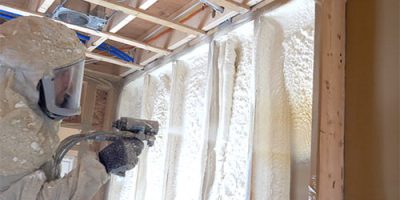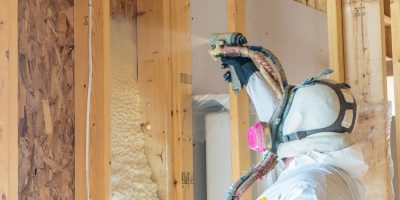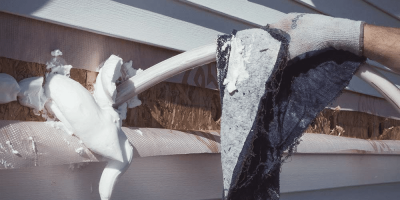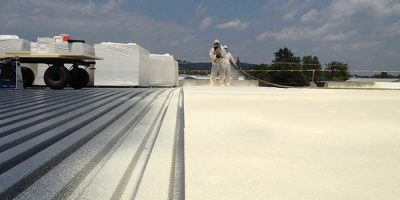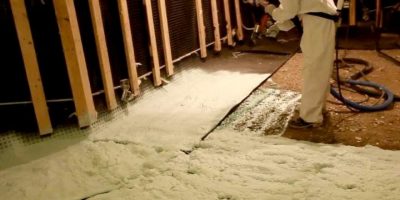With the growing popularity of spray foam insulation, we get a lot of questions from clients about it. Here is an overview of this product and some common questions and answers.
Frequently Asked Questions
What is spray foam insulation?
A: Spray foam insulation, also known as spray polyurethane foam insulation, is a product that is applied with a sprayer that mixes two liquids. The foam expands to fill cavities and cover surfaces completely, and it can be used to insulate in walls, attics, ceilings, floors, and basements and crawlspaces. The two liquids contain the following: “methylene diphenyl diisocyanate (MDI) and polymeric methylene diphenyl diisocyanate (pMDI), polyols, catalysts, blowing agent, flame retardant, and surfactant.”
How is spray foam different from traditional insulation?
A: The main difference between spray foam insulation and more traditional forms of insulation like fiberglass or cellulose is that spray foam insulation is an air barrier and thermal barrier all in one (with closed cell spray foam even offering a moisture barrier as well). This means that spray foam insulation does the job of providing insulation and air sealing with one product, whereas traditional forms of insulation do not provide any barrier to the flow of air. This is important for establishing a continuous and complete thermal/air barrier with the building envelope.
What is the difference between “closed” cell and “open” cell?
A: There are two distinct types of spray foam insulation: open cell and closed cell. Closed cell spray foam cures into a hard, rigid state whereas open cell cures with a spongy, softer feel to it. In terms of R-values, closed cell spray foam is close to R-7 per inch and open cell around R-4 per inch. Also, closed cell becomes an air barrier at only 1” of application, while it takes on average 3” of open cell foam to achieve an air barrier. Another big difference in the two is that open cell is water permeable and closed cell is not. Open cell also has soundproofing qualities that can help in dampening outside noise.
What type of spray foam is best for my home and what if I have a roof leak?
A: While every job and application can be different, we generally recommend open cell spray foam for attic encapsulations and closed cell spray foam for basement or crawlspace encapsulations. Open cell spray foam works best in attics because of its ability to permeate moisture, meaning that if do have a roof leak, the water would pass through it and enable you to see the issue. Because closed cell spray foam is not water permeable, we do not normally recommend it for attic applications since it could trap moisture from a leak and potentially cause issues like rot and damage to your roof. There are some applications where closed cell might be a good option along the roof-line because it can add some structural integrity in hurricane prone/high-wind areas. However, closed cell spray foam makes the most sense for basement and crawlspace encapsulations because it creates a moisture barrier that can keep that damp, musty air from infiltrating into the conditioned space of your home.
How is spray foam different in existing homes versus new construction?
A: On new construction or major renovation projects, we can insulate exterior walls with spray foam or a combination of spray foam and traditional fiberglass batts through a process called “flash and batt.” For existing homes, spraying the attic and crawlspace/basement makes a substantial difference and leads to greater comfort and efficiency – without having to also insulate in walls. Insulating walls on existing homes is a bit invasive, so we can help clients avoid this by focusing on the top and bottom of the thermal boundary of the conditioned space.
Is spray foam insulation safe?
A: Yes, spray foam is safe. Some people can be sensitive to the fumes that come from the installation process. This process is known as off-gassing, which is why we recommend that occupants vacate the home once the spraying has begun and for a period of 12-24 hours after it ends. This will allow for the foam to fully off-gas, and afterwards the home will be completely safe to live in.
Does Peritus spray foam support bacterial and/or fungal growth?
A: Spray foam insulation products do not offer any food value, therefore do not support bacterial or fungal growth. Furthermore, it also does not retain water, making it an unappealing environment for fungal spores. University of Texas has done an experiment on mold growth ability on three different insulation types (fiberglass with foil face and fiberglass with vapor barrier). Peritus was found to be the best deterrent for mold growth among the types tested.
Are there any harmful emissions?
A: Peritus spray foams are safe for both you and the environment. Most Peritus spray foam products are water-blown, and do not emit HFCs or HCFCs. Extensive testing in North America have shown that no VOCs are detected after 30 days following installation. Peritus recommends that once sprayed, Peritus spray foam be allowed 24 hours with adequate ventilation to fully cure.
Peritus spray foam is ideal for use in homes for many environmentally concerned people.
Will it save me money on my power bills?
A: The quick answer is yes, spray foam will save you money on your power bills. The length of time it takes for payback is a harder question to answer. That depends on how you live in the home and use your HVAC system, etc. Our clients report savings between 15-30% on energy bills with a spray foamed house versus traditional existing homes that have fiberglass insulation (and generally do not have proper air sealing).
What are the acoustic properties?
A: As an effective air-seal, Peritus range of open-cell, light-density spray foam products which eliminates the air gaps through which airborne sound travels. As a result, these spray foams are able to noticeably control mid-range frequencies noise, which includes the most common sounds, the human voice and stereo music. Peritus open-cell, light-density spray foam thereby adds to the acoustic property of the building envelope.
What about the “problems” with spray foam?
A: If the chemicals are properly mixed within the recommended temperature range, applied correctly, and allowed time to off-gas, there should be no problems with spray foam. Unfortunately, sometimes the product is not installed properly, and improper installation can cause moisture issues, comfort issues, and financial strain (if it is not providing the intended energy savings). Sadly, some clients have contacted us to repair/re-spray their homes where it was applied incorrectly. Once they contact us we can identify the issues and ensure a proper spray foam job.
Can I make my house too airtight?
A: The answer is, you have to build tight and ventilate right. With the proper use of exhaust fans and heat/energy recovery ventilators, a building envelope can be made tight while clean, healthy air is circulated through the structure. Air leakage needs to be controlled in houses by making wall and attic assemblies as tight as possible. This not only prevents drafts but reduces the amount of airborne noise and dust from entering the building while ensuring that insulated cavities remain moisture-free.

